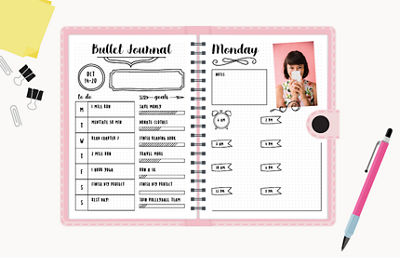How to Bullet Journal With Your Canon IVY

It’s never too late (or too early, for that matter) to get organized. If your day planner is a scattered mess of sticky notes, it might be time to consider starting a bullet journal.
So, what is a bullet journal? In a nutshell, it's a way of organizing your personal thoughts, schedules, reminders, goals and to-do lists. Requiring only a pen and a notebook, bullet journaling was first introduced in 2013 by digital designer Ryan Carroll, and has since become a trendy organizational method. You can add some personality and fun to your bullet journal by using your Canon IVY 2 Mini Photo Printer to print and add photos to your journal.
The Canon IVY 2 is a compact, pocket-sized photo printer that prints peel-and-stick pictures you can place on just about any surface. When paired with the Canon Ivy Mini Print App, you can customize your photos with filters, stickers and effects before printing to make journaling even more enjoyable. And there’s no ink involved – the Canon ZINK Photo Paper comes with all the colors you need to print your favorite photos thanks to its zero ink technology.
Adding photos printed with your Canon IVY 2 is a fun and easy way to turn your bullet journal into a fun, creative project. Read on for our step-by-step guide on how to bullet journal with your Canon IVY 2.

How to make a bullet journal
Any notebook will work as a bullet journal – from a legal pad to a composition notebook. If you're using a journal with a front and back cover, remember that photos are great for personalization. Using your Canon IVY 2, print, peel and stick your favorite photos onto the front and/or back covers of the journal before you dive in.
Step 1: Create an Index
The first page of your bullet journal is your index. This is where you'll keep a running list of the themes and subjects you include throughout. You can refer to the bullet journal index at any time to quickly navigate from section to section.
Step 2: Create a Bullet Journal Key with Symbols
Your bullet journal key is a reference page that you create at the beginning of your journal to explain the symbols and notations you use throughout the journal. Start by choosing your bullet styles. You might opt for a traditional circle or square – the kind of bullets you would use in a PowerPoint presentation or Word document. For something a little more design-forward, you might use an arrow, star, flower or heart – just be sure to clarify the significance of all bullet journal symbols in your journal key. You’d want to define symbols for tasks, events, notes, and other categories. It could also be helpful to color-code your logs. For instance, try writing all your pressing to-dos in red ink as a visual reminder to address these items first.
Step 3: Create a Future Log
Once you’ve created your index and key, start your bullet journal future log. This is where you will keep track of the tasks you hope to complete within the next six months or so. Pick an image that evokes growth and progress, such as a budding flower or a colorful sunset, print it with your Canon IVY 2, and peel and stick it to your log.
Step 4: Create a Monthly Log
After your future log, design your monthly log. This section acts as your calendar, where you systematically track your monthly tasks and events. First, write the name of the month, then going down the page line by line, write the days of the month. Feel free to get creative with the title and styling. You can use the Canon ZINK Pre-Cut Circle Sticker Pack to print decorative sticker titles for each month. Include a photo that accurately captures the mood of the month — maybe a New Year's party hat in January or a heart-shaped candy in February. Use your monthly log bullet journal to note down important dates, events, and goals for the month.
Step 5: Create a Daily Log
The daily log is the heart of your bullet journal and is the next step after creating your monthly log. Every day, write down the date and what you need to accomplish – whether that's doing laundry or finishing a book. Be sure to write your daily tasks as bullet points, referring back to the key you created in step two. You can also pick a photo that captures the mood of each day, then print, peel and stick it to your daily log with your Canon IVY 2. If you are journaling on the go, the Canon IVY 2 comes with a fast-charging USB-C charger that gives you a full charge in 45 minutes and up to 20 prints per charge.
Step 6: Migrate Tasks
At the end of each day, week or month, you'll want to take note of the tasks that have not been completed. You might decide to migrate them to your future log page, especially if you don't see yourself getting to them in the immediate future.
Step 7: Create a New Month
At the beginning of each month, you get to start all over again (see steps four through six).
More Bullet Journal Tips
Be Flexible
The beauty of a bullet journal is it can be adapted to your personal style. Once you’ve learned how to bullet journal, experiment with different layouts, themes and styles to find what works best for you. You can start a new page to organize new tasks whenever you wish. For example, to log a shopping list, simply turn to the nearest blank page, start the list, and note the subject in the index. Remember to use photos to further personalize your journal. Run into an old friend on a shopping day? Take a photo, add suitable frames or filters with the Canon Ivy Mini Print App, then print and add to your daily log.
Embrace Your Inner Artist
Some of the most eye-catching bullet journals double as scrapbooks. Many people use their bullet journals to express themselves through doodles, photos, illustrations, and various artistic elements. You can transform the blank pages of your bullet journal into colorful photo collages, or cover the front and back covers of your notebook with some of your favorite shots from the year. We've shared a few idea-starters here, but the real creative work is up to you! Document your daily accomplishments with photos, and using your Canon IVY 2 Mini Photo Printer, print, peel and stick those photos to your daily log. If you run out of printing paper at any time, grab some photo replacement sheets and keep the fun going.
Bullet journaling is a great habit to pick up at the start of a new year. Once the notebook is filled with thoughts, lists, quotes and lots of photos, be sure to store it somewhere safe. Who knows? You may want to look back one day and remember everything that you aspired to this year.


